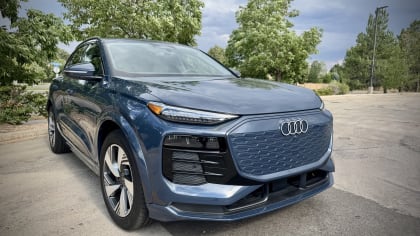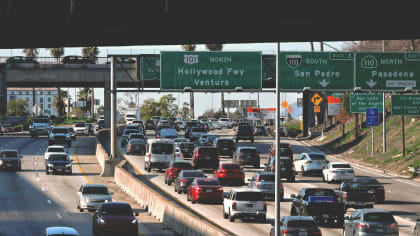LONG BEACH GRAND PRIX
No Slowing Down at the Big Race
This article is from our archives and has not been updated and integrated with our "new" site yet... Even so, it's still awesome - so keep reading!
Published on Mon, Apr 18, 2016
By: The LACar Editorial Staff

Story by Brian Kennedy, PhD
Pictures by Gabriela Moya
The only time the IndyCar field slowed down Sunday afternoon was to end the race, once Simon Pagenaud had been crowned the King of Long Beach. Otherwise, the 21-car field ran flat out for the entire 80 laps that comprised the Toyota Grand Prix of Long Beach. That’s a total of just under 160 miles at 100.592 mph average. It was the fourth time this race had run caution-free, but the first such race since April 16th of 1984 at this track. The last all-green race in the series was in August of 2013 at Mid-Ohio.
There were six lead changes amongst four drivers. Helio Castroneves started on the pole and finished third. Scott Dixon went from second to, well, second, though he led and felt that he should have won. Charlie Kimball led on pit strategy, and Pagenaud obviously led, since he won. He tallied 28 laps in this category to Castroneves’s 47. Dixon led the fewest, at two, but he was sure that he would have won had Pagenaud not cheated the pit blend line and entered ahead of him to take the lead on lap 56.
H was coming out, I had started to back off already [on fuel] because I didn’t think I had to worry about Helio. I didn’t get any warning from the pits. That scenario was a lot closer than I anticipated.” So far, so polite.
He was just getting warmed up.
He then explained the offense as he perceived it. “When we got to turn one, it appeared that Simon turned in a little early, and crossed the line that you weren’t meant to cross, but it is what it is.”

It got better. “Personally, I thought we should have won the race.” He was then asked what was understood about the yellow line at the end of pit road, responding, “This one’s always very clear, and we have two drivers’ meetings a weekend, and it was clearly stated. I think if you look at the pdf, it’s even in the pdf that everybody gets. In the first [meeting] on Friday, it was asked about that, and by all means, at any time you could not put more than two wheels over the line. I thought we had done with warnings and all this sort of wish-wash stuff and we were going to stick to hard rules, but obviously that wasn’t the case today.”
The IndyCar official in the meeting tried to clarify, saying that the rule stated that a warning could be issued. Dixon jumped right in: “In defense of that, I thought we had outlawed warnings. Yes a warning is clarified at some points, but this is the problem we had in the off-season with people getting warnings all the time, especially when you’re using it to your advantage when it’s the last pitstop sequence. That’s why this was discussed so deeply in the off-season and why there was about 40 or 50 warning zones in the rulebook removed. I don’t even know why we discuss the pitzone exit if we’re not going to stick to rules. Everybody else abided by them.”
He expressed his feeling at being cheated. “A win’s a win, and in scenarios like this, you shouldn’t be fighting over nothing’s called.” In other words, he was robbed. He said he was pretty mad in the last 15 laps and when he got out of the car, and mad at Pagenaud after the race. But “he doesn’t make the rules or put the rules forward . . . . I’ll direct my anger in some other direction.”
In fact, Dixon didn’t even wait to get to the pressroom to start his complaints about Pagenaud. He said on the mic out in the field that Simon had all four tires across the blend line on pit lane, entering the track before he should have. He said that this received a warning but that it should have caused a penalty.
In the interview room, the press kept hammering away at him, asking again for his views. He explained that he could see Pagenaud before he blended, and that the way things were set up, there’s a long way that the car has to go before he can join the racing action, so he didn’t expect the French driver to cut in front of him where he did. Dixon said again, “It shouldn’t be a judgment call. It’s a rule.”
The winner, Pagenaud, was also very clear in seeing things his way. “I didn’t know. Nobody mentioned it. I just focused on the job. I really honestly didn’t know it was that close . . . . It made it great for TV, but IndyCar has made it really clear this year what you can and cannot do, and it was certainly was on the verge of being a stronger penalty, but I did get a warning. I only did it once in the race. There was a clear understanding from race control.” He later pointed to the manual that the series had sent to all the teams. “Going in the race, I know the rule book. I know that that line, you can take risks, you can get on the limit, it’s just racing at the end of the day. Like I said, another inch to the right would not have changed the outcome of the race.” (Not what Dixon thought, right?)

Twenty-one cars took the green, and all were running at the end. This has not happened since the second race at Texas in 2011. Not all were on lap 80, though. Andretti and Rossi were down a lap, Hawksworth down three. But even at that, the field was close. Pagenaud’s average speed was 100.592mph, while Hawksworth’s was 98.132.
The race took just more than an hour and a half, which prompted someone to ask the winner whether he thought that next year, the race should be longer. “I won, I’m happy! No, I don’t have any. . . it was very quick. The pace of the cars are really fast nowadays. Compared to ten years ago, we brake really late. We carry a lot of speed into the corners. There’s a lot of downforce. We can pass on the straights too. We go up to 190 [mph] on the straights. I know as a driver it was fun for me. It was pure racing. It’s not as exciting from outside, but the pit sequence is exciting.”
Castroneves responded to the same question by talking about strategy: “It’s rare for it to go green [the whole way], but that’s related to the aero package, which makes it tough to get close to another guy. It was tough, but I feel that probably those are the scenarios. You can’t get close. It was very difficult to pass.”
Most cars did the race on two stops. A few took three.
The race did, it must be said, did become a bit of a parade, always the fear on a circuit like this. But there were some battles. Dixon was just behind Pagenaud, coming to his gearbox on the last turn onto the front straight, for instance, and making fans feel like he could pull out and pass. He had used up his “push-to-pass” bursts earlier, he said. The drivers had ten of these available. Each gave them 20 extra horsepower for 20 seconds.
From third to fifth was covered by only a second and a half. Sixth-seventh-eighth was similarly packed up, as was ninth through eleventh. After that, it was one long line to the end. That last car on the lead lap, in fact, was about a minute behind the first. A lap took about 1:09 early in the race, longer than that in the later going.
Pagenaud had the fastest lap of the day, at 68.8 seconds, and he set that on lap 53 of 80.
Had you been there, you would have experienced a very warm and sunny day, slightly windy but not as much as Saturday. Good thing the race was on the weekend it was, because the one prior was rainy. Next year, it’s scheduled a week earlier.

The race began at about 1:45. Earlier in the day, Graham Rahal had posted a blistering practice time, but he started 17th due to a lousy qualifying effort after a wreck. He would move up only two spots on the day. Two parade laps were followed by a pace lap. Castroneves led Dixon. Last year, they finished in the opposite order to this. Pagenaud was third. The top six cars were all Chevrolets. Castroneves led to turn one, no wreck happened behind him, and everyone was away. At the back of the pack, Marco Andretti slowed briefly but got his momentum again. At the front, Pagenaud bumped past Dixon for second. On lap seven, Charlie Kimball, who had started 15th, tried the off-sequence pit strategy. He would lead twice in the race for a total of three laps, but finish 11th, the strategy not paying off because there were no yellow flags. Two other back-in-pack players, Hawksworth and Chilton, tried the same thing in the few laps following Kimball’s early pitstop. The majority of the cars started to pit around lap 20, with most waiting a little past that point. Castroneves pitted from first on lap 27, with Pagenaud going with him. Dixon pitted on lap 28. Will Power waited about the longest, coming in on lap 31. He would find himself seventh at the end off a sixth starting position. At the halfway point, the top seven cars were close, and by lap 51 it was Castroneves, Dixon, Pagenaud, Power, then Kanaan followed by Montoya and Sato. The top ten cars were within fourteen seconds of each other. Castroneves might have been able to close, but he said after, “We had to save a ton of fuel. I just don’t understand, since stopped one lap earlier than me, why we had to save more fuel than them. I don’t understand, but well, third place obviously is great to collect points.” He also got the bonus point for leading the most laps on the day. After another pit stop, the controversy regarding Pagenaud having the lead was brewing. Dixon was right behind him, pressuring for the lead, with about 25 laps to go. They continued to battle, but there was never any clear threat of a pass by Dixon. As the checkered flag fell, Graham Rahal’s engine died, and he lost a spot to Chilton. Other notable finishes: Kanaan in sixth, Bourdais, a former winner, in 9th, and Sato in fifth. He’s won here before also. Pagenaud gained his fifth career win and his first with the Penske team. His last victory was with his old team, at Houston (race #2) in 2014. Roger Penske has now gained 179 IndyCar victories. Follow Brian on Twitter @growinguphockey To read Brian’s Pole Qualifying at the Toyota Grand Prix, click here. [nggallery id=lbgpraceday2016] [nggallery id=lbgpracedayplus2016]




